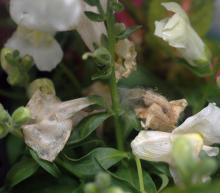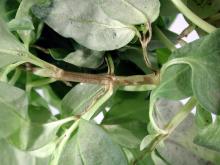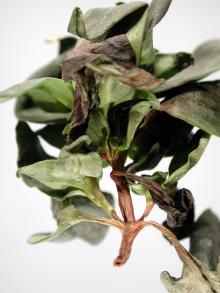See:
Greenhouse Plants, Ornamental - Gray Mold
Cause Botrytis cinerea (sexual: Botryotinia fuckeliana) and other Botrytis spp., fungi that colonize dead, dying, and wounded plant parts. From these infections they can attack healthy tissues. A moist, humid environment is ideal for pathogen sporulation and spread. Spore dispersal is stimulated by changes in relative humidity. Conidia may come from many sources in and outside the greenhouse. Concentrations peak in the greenhouse during irrigating, spraying pesticides, harvest, and shipping. It is found everywhere plants are grown and has a wide host range wide host range including African violet, ageratum, ajuga, aphelandra, aster, begonia, caladium, calceolaria, carnation, chrysanthemum, coleus, cyclamen, fuchsia, geranium, gloxinia, hosta, Iberis, impatiens, lily, lobelia, marigold, orchid, pansy, Pericallis hybrids, petunia, poinsettia, primrose, rose, snapdragon, verbena, viburnum, zinnia, and zygopetalum. Geranium is considered highly susceptible to a point that it could be a significant harbor of the pathogen for other greenhouse crops. Flower petals are most susceptible at any stage of development. Blossom blight, leaf spots, and bud and stem rots are common. Leaf blights can start when infected floral tissue falls on healthy leaves.
Symptoms Blighting of leaves, petioles, blossoms and stems is the most common symptom. Initial infections, particularly of petals, appear as water-soaked brown to tan spots. In humid conditions, a fuzzy fungal growth, brown to gray, appears around the infected plant part. Infections move quickly to healthy tissues under ideal conditions. First symptoms may be the wilting of flower spikes once the stems below have been girdled.
Cultural control An integrated strategy combining environmental management, cultural practices, regular scouting and fungicides will most effectively manage this disease.
- Thoroughly clean and sanitize the greenhouse before production.
- Remove all dead and dying plant parts (particularly blossoms) on and around plants and take them out of the greenhouse. Many growers use closed containers to minimize the amount of conidia.
- Maintain a steady, relatively dry environment by keeping greenhouse humidity below 90%, increasing spacing between plants for good air circulation, and taking care not to splash water on foliage during watering. Heating the greenhouse at night (especially for zero or negative DIF) or venting around sunset may be necessary. Heating in the morning before sunup can also help prevent dew formation as air temperature increases faster than the temperature of plant parts. If using DROP or DIP for size control, do not let humidity rise above 90%.
- Spacing plants also allows better light penetration, reducing senescence of the lower leaves and thus helping reduce the amount of highly susceptible plant tissue.
- Eliminate weeds from inside the greenhouse and around doorways and vents outside of the greenhouse.
- Avoid leaving large stubs on stock plants after cutting.
- Place fans in greenhouse to get better air circulation.
Chemical control Fungicides do not compensate for poor sanitation or environmental controls. Resistance to many different and multiple fungicide groups has been documented worldwide. To prevent developing resistant fungi, alternate or tank-mix materials from different groups with different modes of action. Also, limit applications from any specific group to two (2) or fewer sprays.
- Astun at 10 to 17 fl oz/100 gal water. Group 7 fungicide. 12-hr reentry.
- Broadform at 4 to 8 fl oz/100 gal water. Group 7 + 11 fungicide. 12-hr reentry.
- Chipco 26019 FLO at 1 to 2.5 quarts/100 gal water. Group 2 fungicide. 12-hr reentry.
- Decree 50 WDG at 0.75 to 1.5 lb/100 gal water. Group 17 fungicide. 12-hr reentry.
- Mancozeb-based products can be used as mixing partners and provide some protection. Group M3 fungicides. 24-hr reentry.
- Fore 80 WP at 1.5 lb/100 gal water plus a spreader-sticker.
- Protect DF at 1 to 2 lb/100 gal water plus 2 to 4 oz spreader-sticker.
- Medallion WDG at 2 to 4 oz/100 gal water. Use with oils or adjuvants may cause plant damage. Group 12 fungicide. 12-hr reentry.
- Mural at 4 to 7 oz/100 gal water. Group 7 + 11 fungicide. 12-hr reentry.
- Orkestra at 8 fl oz/100 gal water. Group 7 + 11 fungicide. 12-hr reentry.
- Pageant at 12 to 18 oz/100 gal water. Do not use with organosilicone-based adjuvants. Group 7 + 11 fungicide. 12-hr reentry.
- Palladium at 4 to 6 oz/100 gal water. Avoid excessive runoff to small plants, which may result in stunting and/or chlorosis. Group 9 + 12 fungicide. 12-hr reentry.
- Phyton 27 at 1.3 to 2 oz/10 gal water. Group M1 fungicide. 48-hr reentry.
- Spirato GHN at 2 to 4 fl oz/100 gal water. Use with oils or adjuvants may cause plant damage. Group 12 fungicide. 12-hr reentry.
- Terraguard SC at 4 to 8 fl oz/100 gal water. Group 3 fungicide. 12-hr reentry.
Reference Bolton, A.T. 1976. Fungicide resistance in Botrytis cinerea, the result of selective pressure on resistant strains already present in nature. Canadian Journal of Plant Science 56:861-864.
Wegulo, S.N. and Chase, A. R. 2017. Diseases of Snapdragon. In McGovern, R.J., and Elmer, W.H. (eds.) Handbook of Florists' Crops Diseases. Springer Int.




